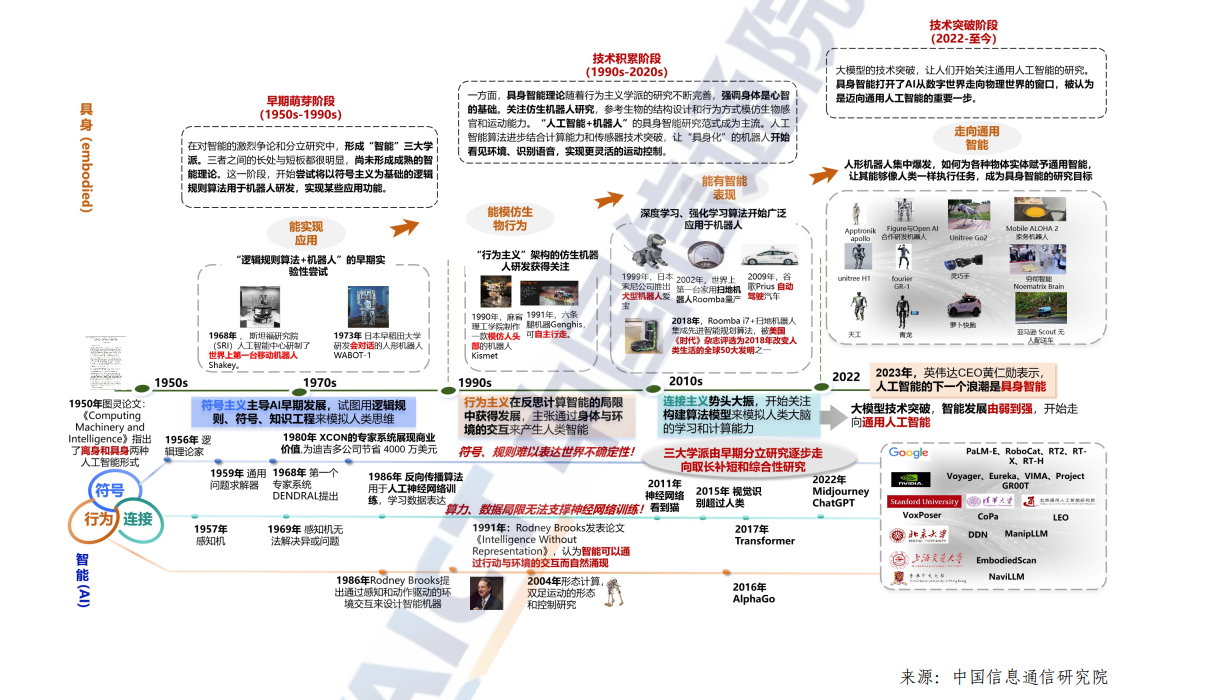The report points out that embodied intelligence and detached intelligence complement each other and develop collaboratively to promote the understanding, simulation and expansion of intelligence. The theory of embodied cognition can be traced back to the 40s of the 20th century, when some philosophers and psychologists began to focus on the role of the body in cognitive processes. For example, the French philosopher Merleau-Ponty emphasized in his writings that bodily experience is the basis of cognition. Since then, the theory of embodied cognition has continued to develop, laying a theoretical foundation for the emergence of embodied intelligence.
The development of embodied intelligence
From the perspective of artificial intelligence, the 1950s-1980s were the early stage of theoretical exploration. In 1950, Alan Turing proposed the concept of "learning machines" in his paper "Computing Machines and Intelligence" and discussed the question of whether machines can think. However, these early AI systems lacked a physical body and could not interact directly with the environment, so they were out-of-body intelligences. In the fields of cognitive science, psychology, and neuroscience, scholars have continuously deepened their research on human perception, motor control, and emotion. For example, psychologist Howard Gardner proposed the theory of multiple intelligences in 1983, which involves spatial intelligence and motor intelligence, which has some similarities with the concept of embodied intelligence.
Technological exploration and initial development stage
The beginning of robotics: Since the middle of the 20th century, with the development of computer technology and automation technology, robotics has gradually emerged. Early robots were mainly represented by industrial robots, which were able to complete some simple repetitive tasks in a specific production environment, but these robots lacked autonomous intelligence and mainly relied on preset programs to run.
Initial integration of artificial intelligence: In the early stage of artificial intelligence development, people began to try to apply some simple intelligent algorithms to robots, so that robots can have certain perception and decision-making capabilities. For example, some robots are able to perceive environmental information through sensors and perform operations such as path planning and obstacle avoidance according to simple rules.

Figure: The development of embodied intelligence
Deep integration and rapid development stage
Driven by deep learning technology: Since the beginning of the 21st century, deep learning technology has made major breakthroughs, providing strong technical support for the development of embodied intelligence. Deep learning algorithms enable robots to better understand and process visual, auditory, and other multimodal information, thereby enabling more natural human-computer interaction and more complex task execution.
The development of multimodal perception and interaction: With the continuous advancement of sensor technology, robots can obtain richer and more accurate environmental information. For example, through the fusion of multiple sensors, such as vision, hearing, and tactile sensors, robots can perceive the world around them and respond accordingly like humans.
Application of reinforcement learning: The application of reinforcement learning in embodied intelligence is also becoming more and more widespread. Through reinforcement learning, robots are able to continuously learn and optimize their behavioral strategies in their interactions with the environment, so as to better adapt to complex and changing environments.
From the perspective of robotics, early robotics research mainly focused on mechanical engineering and locomotor capabilities, without the need to collaborate with humans, and the application scenarios mainly focused on replacing human labor and automation in industrial scenarios.
With the development of artificial intelligence technology, robots have begun to combine with embodied intelligence, such as Tesla Path, which advocates the combination of humanoid robots with embodied intelligence, emphasizing the support of AI infrastructure. In 2023, humanoid robots will be gradually improved at the Intelligent Technology Exhibition of the 7th World Intelligence Congress, providing a direction for the implementation of embodied intelligence. In 2024, the Figure 01 robot will be unveiled, the Source Code Service Robot Research Institute of the Chinese Academy of Sciences will release the country's first "Made in Wenjiang" embodied intelligent robot based on logistics scenarios, UBTECH's Walker S1 robot will be trained in automobile factories and other scenarios, and Leju Robot "KUAVO" will begin to explore the application of industrial scenarios. The application of these robots in different scenarios has promoted the development of embodied intelligence in practical tasks, making it move from the laboratory to real-world applications.
In 2024, the field of humanoid robots will be actively funded, and the number of complete machine companies will increase. In 2025, the government work report proposes to cultivate the embodied intelligence industry, and various localities have also introduced policy support to promote the development of the embodied intelligence industry. At the same time, the market demand for embodied intelligent products and services continues to grow, including intelligent manufacturing, medical services, home care and other fields of application scenarios continue to expand, prompting robot companies to continue to develop and improve embodied intelligent robots to meet market demand.
Related:
Analysis Development of Embodied Intelligence (1)
Analysis Development of Embodied Intelligence (2)
Analysis Development of Embodied Intelligence (3)
Analysis Development of Embodied Intelligence (4)
Analysis Development of Embodied Intelligence (5)
Analysis Development of Embodied Intelligence (6)






